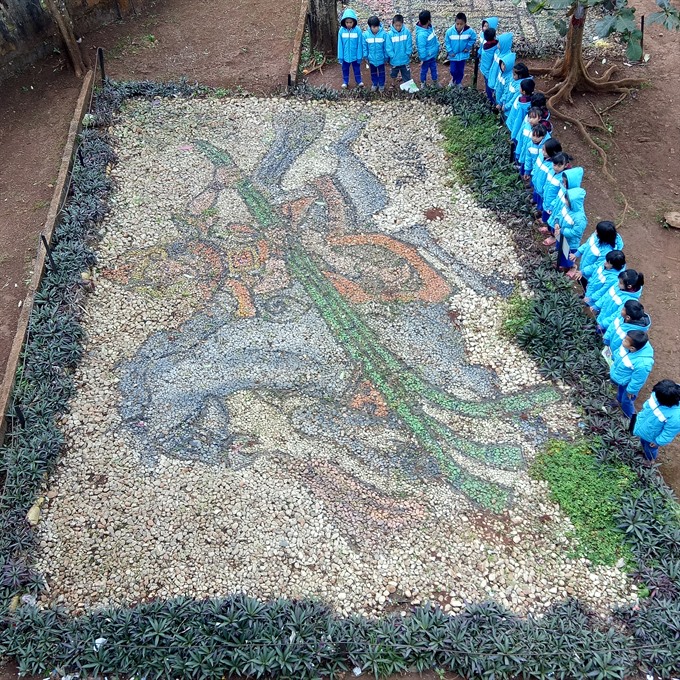 |
| Big art: A picture of Saint Giong is made of pebbles and flowers at Huong Phung School. Photo courtesy of Huong Phung Primary School |
Viet Nam News
by Luong Thu Huong
Students of the Huong Phung Primary School learn about history and culture not only in their textbooks but also through lively replicas installed in the school premises.
Entering the mountainous school, located in a remote area in the central province of Quang Tri, is like stepping into a mini museum.
There are eight impressive replicas on the 1,000sq.m premises, which help students visualise both national and local culture and history. The replicas include the sovereignty landmark on the Truong Sa Island in the central province of Khanh Hoa, Gac Ma Island, Viet Nam’s map, a picture of Saint Giong, the Vinh Moc guerilla warfare tunnels, President Ho Chi Minh’s stilt house and a traditional stilt house of the Pa Ko-Van Kieu ethnic minority.
“The idea for the models originated from the fact that a majority of the students belong to the Van Kieu community, who lack the opportunity to travel to learn new things. They encounter many difficulties in their studies and in gaining knowledge,” says Nguyen Mai Trong, the school’s principle.
“Supplementing the knowledge in the textbooks, the visual models are expected to deepen the students’ understanding, in addition to nurturing their love and respect for the history and culture of their hometown as well as nation,” Trong says, adding such models also help improve students’ interest in studies.
Besides educational purposes, the models have also beautified the area of the Huong Phung School, which consists of 33 classes with more than 650 students.
Awareness about national sovereignty
According to the principle, as a school located near the Viet Nam-Laos border, the highlight of its education is to impart knowledge to the students about national sovereignty of the land and islands. Therefore, the first replica to be installed was Viet Nam’s sovereignty landmark on the Truong Sa Island.
The idea for the replica was proposed in April 2015 by Trong and it was completed five months later, with contributions from benefactors who heard about the idea on social networking sites. Every Monday, when students attend the flag salutation ceremony, the sovereignty landmark is expected to make them aware of national sovereignty.
Following the positive response of the students to the first replica, the school authorities next decided to install a picture of Viet Nam’s map. This was created from pebbles and flowers.
For weeks, both teachers and students voluntarily went to the nearby Chenh Venh Stream on their off days to collect pebbles, and they together created the map. While small pebbles were used to form the mainland, two big stones were used to represent the Truong Sa (Spratly) and Hoang Sa (Paracel) Islands, and purple flowers were planted around the borders of the map.
Since its installation, the map has been the favourite spot for students to visit during breaks or extra-curricular activities.
“We gather here at every break. Sometimes we play a game of questioning each other about the locations of various provinces and islands, which increases our understanding of the country,” says Ho Van Hung, a fifth grade student.
The most sophisticated replicas are those of the Vinh Moc Tunnel System, which has been recognised as a national special heritage site, and the traditional stilt house of the Van Kieu-Pa Ko ethnic groups.
The uneven terrain on which the school is located gave teachers the idea to build a replica of the tunnels.
The tunnels served as a strategic location on the border of the North and South Viet Nam during the American War. It was built to protect people from the intense bombings in Son Trung and Son Ha communes in Vinh Linh District of Quang Tri Province in the Demilitarised Zone.
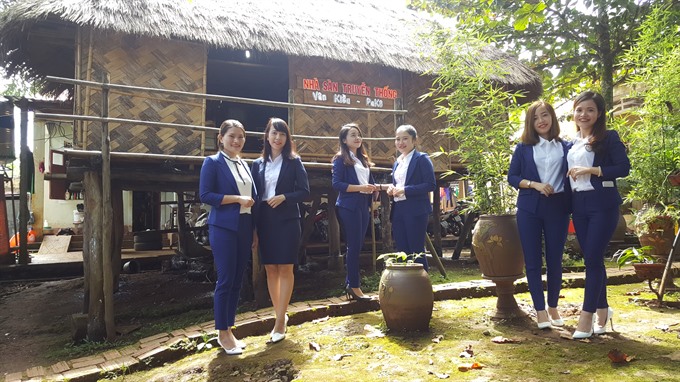 |
| Active learning: A traditional stilt house of the Van Kieu - Pa Ko ethnic minority has been erected on Huong Phung schoolyard to educate the students about local cultural identities. Photo courtesy of Huong Phung Primary School |
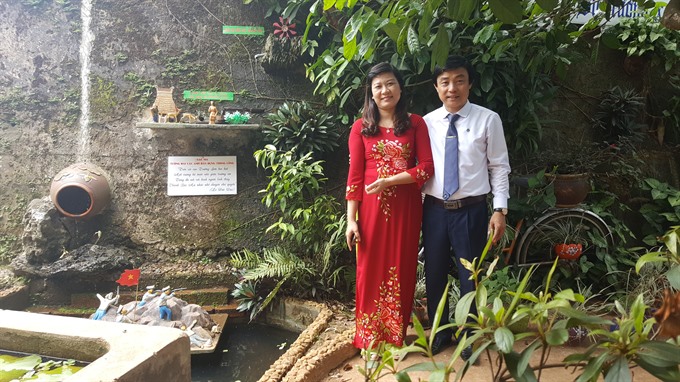 |
| Inspiration: Principle of Huong Phung Primary School, Nguyen Mai Trong (right), poses in front of the replica of Gac Ma Island. Photo courtesy of Huong Phung Primary School |
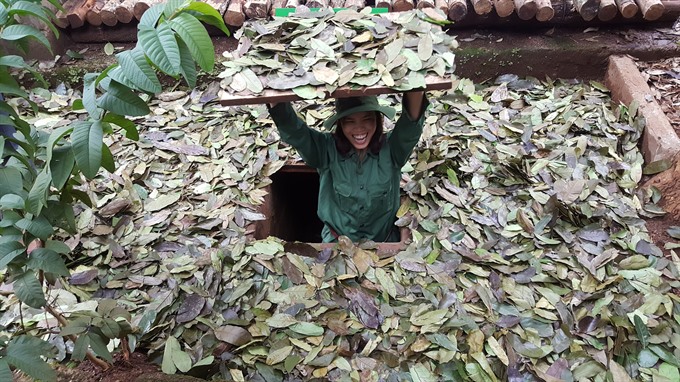 |
| Underground: The replica of the Vinh Moc Tunnel System, which has been recognised as a national special heritage site, is one of the most sophisticated constructions on Huong Phung Schoolyard. Photo courtesy of Huong Phung Primary School |
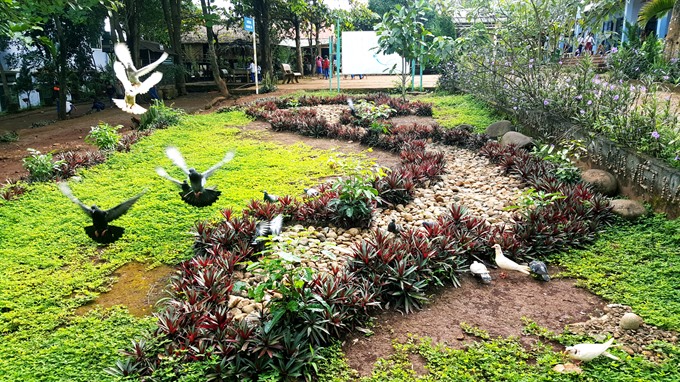 |
| Little country: The map of Viet Nam, made of pebbles and flowers, is a popular destination for the students during break. Photo courtesy of Huong Phung Primary School |
In the replica, the teachers have duplicated the original living conditions of the families who used to seek shelter in the tunnels by displaying authentic household items donated by the local people of Vinh Linh District.
“It is also another way of study,” Trong says. “It does not require much explanation. The teachers only need to introduce briefly, and then by walking up and down the tunnel everyday, students will be reminded of a significant historical phase in the Demilitarised Zone.”
Preserving cultural identities
Another central point of the education system of the Huong Phung School is 70 per cent of whose students belong to the Van Kieu-Pa Ko ethnic community, is contributing to the preservation of local cultural identities.
That is why the school’s managing board mobilised for the construction of the Van Kieu-Pa Ko stilt house as one of the eight replicas. Notably, over 40 household items had been donated by the local people to be displayed in the house.
Trong says the preservation of the replicas has encountered quite a few difficulties due to natural factors such as rain, sunshine, weed, moss or wood-eaters, but the students and teachers have always taken good care of the exhibits to preserve them for a long-term use.
He revealed that the next replica would be the wooden statue of national hero Tran Quoc Tuan, which is expected to arouse feelings of patriotism among the students.
“It would be a grand replica of history, culture, education and spirit that has taken up significant amount of time and expenses,” Trong says, adding the construction of the statue has received the support of several benefactors and is expected to be completed before the start of the new academic year. VNS
OVietnam